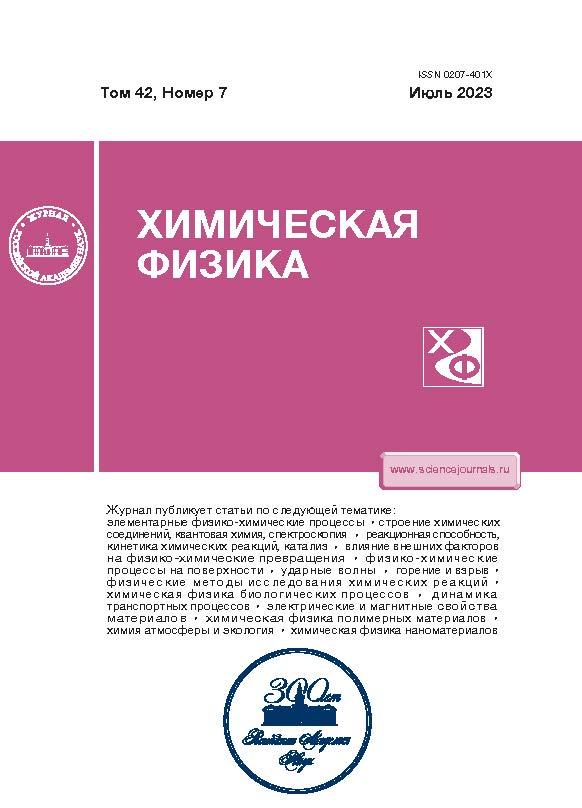Specific Features of the Decay Kinetics of an Excited Singlet State Into a Pair of Triplet Excitons In Rubrene Crystals
- 作者: Shushin A.I.1, Umanski S.Y.1, Chaikina Y.A.1
-
隶属关系:
- Semenov Federal Research Center for Chemical Physics, Russian Academy of Sciences
- 期: 卷 42, 编号 7 (2023)
- 页面: 86-94
- 栏目: XXXIV СИМПОЗИУМ “СОВРЕМЕННАЯ ХИМИЧЕСКАЯ ФИЗИКА” (СЕНТЯБРЬ 2022 г., ТУАПСЕ)
- URL: https://rjmseer.com/0207-401X/article/view/674856
- DOI: https://doi.org/10.31857/S0207401X23070178
- EDN: https://elibrary.ru/YGNLPM
- ID: 674856
如何引用文章
详细
In this study, the specific features of the kinetics of singlet fission (SF)—i.e., spontaneous splitting of the excited singlet state into a pair of triplet (T) excitons (TT-pair)—in anisotropic molecular crystals are analyzed in detail. These features are known to be primarily determined by the TT-annihilation of the created TT-pairs (migrating in the crystals). In our analysis, the kinetics of annihilation-affected SF processes is described in the two-state model (TSM), in which the interaction of migrating T-excitons is associated with transitions between two kinetic states of TT-pairs: [TT]-state of coupled TT-pairs and [T+T]-state of freely migrating T-excitons. The TSM makes it possible to represent the effects of migration and interaction on SF-kinetics in terms of the lattice Green’s functions, for which the analytical formulas are obtained in this study. The TSM is applied to the analysis of SF-kinetics in the rubrene single crystals recently measured in a wide time range. The analysis provides detailed information on some characteristic kinetic properties of SF processes in anisotropic crystals. It is shown, for example, that the formation of the [TT]-state in the SF process results in some distortion of the shape of the SF kinetic dependence at short times (of the order of the primary-stage time of SF kinetics). Is also demonstrated that the anisotropy of T-exciton migration manifests itself in some characteristic features of SF kinetics at long times.
作者简介
A. Shushin
Semenov Federal Research Center for Chemical Physics, Russian Academy of Sciences
Email: shushin@chph.ras.ru
Moscow, Russia
S. Umanski
Semenov Federal Research Center for Chemical Physics, Russian Academy of Sciences
Email: shushin@chph.ras.ru
Moscow, Russia
Yu. Chaikina
Semenov Federal Research Center for Chemical Physics, Russian Academy of Sciences
编辑信件的主要联系方式.
Email: shushin@chph.ras.ru
Moscow, Russia
参考
- Smith M.B., Michl J. // Annu. Rev. Phys. Chem. 2013. V. 64. P. 361.
- Casanova D. // Chem. Rev. 2018. V. 118. P. 7164; https://doi.org/10.1021/acs.chemrev.7b00601
- Miyata K., Conrad-Burton F. S., Geyer F. L. et al. // Ibid. 2019. V. 84. P. 4261; https://doi.org/10.1021/acs.chemrev.8b00572
- Merrifield R.E. // J. Chem. Phys. 1968. V. 48. P. 4318; https://doi.org/10.1063/1.1669777
- Suna A. // Phys. Rev. B. 1970. V. 1. P. 1716; https://doi.org/10.1103/PhysRevB.1.1716
- Shushin A.I. // J. Chem. Phys. 2022. V. 156. P. 074703; https://doi.org/10.1063/5.0078158
- Tarasov V.V., Zoriniants G.E., Shushin A.I. et al. // Chem. Phys. Lett. 1997. V. 267. P. 58; https://doi.org/10.1016/S0009-2614(97)00056-0
- Ветчинкин А.С., Уманский С.Я., Чайкина Ю.А. и др. // Хим. физика. 2022. Т. 41. № 9. С. 72; https://doi.org/10.31857/S0207401X22090102
- Ryansnyanskiy A., Biaggio I. // Phys. Rev. B. 2011. V. 84. P. 193203; https://doi.org/10.1103/PhysRevB.84.193203
- Barhoumi T., Monge J.L., Mejatty M. et al. // Eur. Phys. J. B. 2007. V. 59. P. 167.
- Piland G.B., Burdett J.J., Kurunthu D. et al. // J. Phys. Chem. 2013. V. 117. P. 1224; https://doi.org/10.1021/jp309286v
- Шушин А.И. // Хим. физика. 2017. Т. 36. № 11. С. 17; https://doi.org/10.7868/S0207401X17110085
- Pilland G.B., Burdett J.J., Dillon R.J. et al. // J. Phys. Chem. Lett. 2014. V. 5. P. 2312; https://doi.org/10.1021/jz500676c
- Steiner U.E., Ulrich T. // Chem. Rev. 1989. V. 89. P. 514; https://doi.org/10.1021/cr00091a003
- Blum K. Density Matrix Theory and Applications. N.Y.: Plenum Press, 1981.
- Shushin A.I. // Chem. Phys. Lett. 1985. V. 118. P. 197; https://doi.org/10.1016/0009-2614(85)85297-0
- Shushin A.I. // J. Chem. Phys. 1991. V. 95. P. 3657; https://doi.org/10.1063/1.460817
- Shushin A.I. // Ibid. 1992. V. 97. P. 1954; https://doi.org/10.1063/1.463132
- Wolf E.A., Biaggio I. // Phys. Rev. B. 2021. V. 103. P. L201201; https://doi.org/10.1103/PhysRevB.103.L201201
- Shushin A.I. // J. Chem. Phys. 2019. V. 151. P. 034103; https://doi.org/10.1063/1.5099667
- Shushin A.I. // Chem. Phys. Lett. 2017. V. 678. P. 283; https://doi.org/10.1016/j.cplett.2017.04.068
- Лаврентьев M.A., Шабат Б.В. Методы теории функций комплексного переменного. М.: Наука, 1973.
- Buchachenko A.L. // Russ. J. Phys. Chem. B. 2022. V. 16. P. 9; https://doi.org/10.1134/S1990793122010031
- Buchachenko A.L., Kuznetsov D.A. // Russ. J. Phys. Chem. B. 2021. V. 15. P. 1; https://doi.org/10.1134/S1990793121010024
- Лундин А.А., Зобов В.Е. // Хим. физика. 2021. Т. 40. № 9. С. 41; https://doi.org/10.31857/S0207401X21090077










